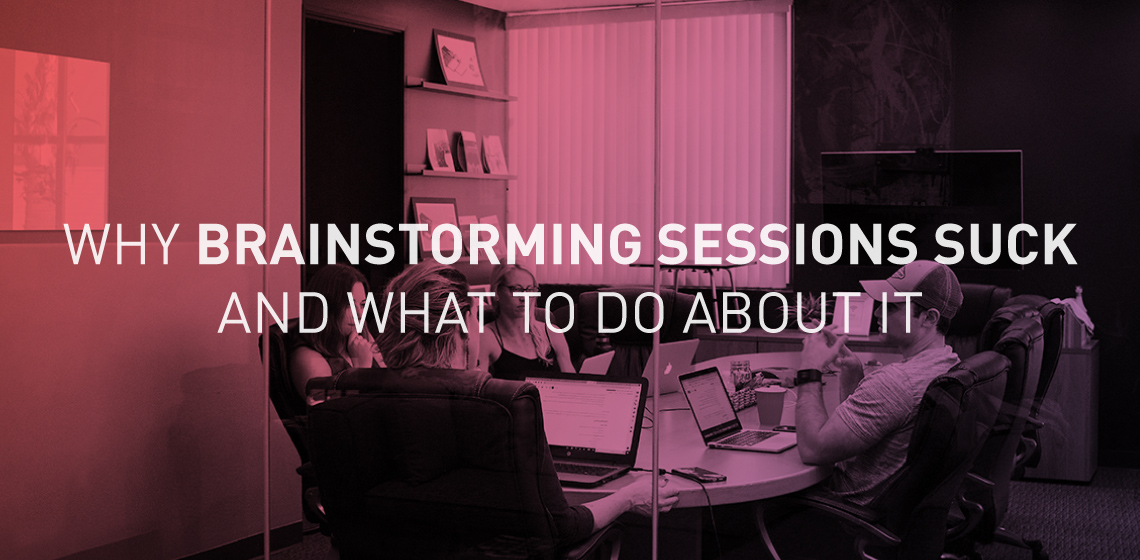Why Brainstorming Sessions Suck and What to Do About It

Brainstorming Sessions Suck
Most of us know the feeling of being awkwardly put on the spot in front of a group of colleagues to answer a question, offer an opinion, or contribute to a conversation that we just aren’t prepared for. For decades, the default method for idea generation in the business world has been team brainstorming sessions. These messy meetings essentially try to force an environment of collaboration, agreement and spontaneous problem solving that sounds great in theory but rarely produces ideas of value. Brainstorming sessions suck.
“It attempts to force an environment of collaboration, agreement and spontaneous problem solving that sounds great in theory but rarely produces ideas of value.”

The concept of professional brainstorming was popularized in the 1950s by advertising executive Alex Osborne and detailed in his book, Your Creative Power. The basic premise is to assemble a group of people to find a creative solution to a problem or produce a fresh idea. In an ideal brainstorming session, all ideas (including far-fetched or hair-brained ones) are welcomed and confidence-killing criticism is not allowed.
In these well-intended meetings, everyone is encouraged [and sometimes required or pressured] to speak up. The thought is that by throwing a team together in this way, group members will feed off of each other. Fair enough. Lock a group of co-workers in a room together, throw in some sticky notes and markers, maybe order lunch and voila! The problem is solved; new ideas are generated. Successful meeting! Right? Not exactly.
In a controversial and often-cited 2012 article published in The New Yorker, Jonah Lehrer described research that suggests individuals may actually generate more ideas on their own than when they’re in teams. Without the convolutions of social pressures and sensitivities, people can engage in thorough and in-depth thought, allowing for more original ideas with greater creativity.
Individuals are simply better at thinking broadly to develop a range of fresh ideas. Groups, on the other hand, can be more effective at sifting through a pile of ordinary ideas to find one extraordinary idea that might be worth pursuing.
4 Reasons Brainstorm Sessions Aren’t Effective
There are several reasons why brainstorming sessions aren’t giving you or your team the results you’re hoping for. These are four of the most common pitfalls we’ve seen…
1. Stage Fright
Naturally, we can all worry about what other people think of us. We fear that other people have more knowledge, experience, or creativity than us. In a group setting, we censor or sometimes even belittle our own ideas to make them mesh with the [perceived] group ideology. This is especially a problem for introverts who may need more isolated time to process their ideas prior to presenting them. The social anxiety caused by a group brainstorming session isn’t conducive to creating the environment necessary for free-flowing thought.
2. The Bystander Effect
People are often less likely to take action when part of a group. Believe it or not, people can make less of an effort when they work in a team compared to working alone. It is common for participants to feel less motivated to contribute when they figure someone else might carry the load for them. They rationalize this passivity by assuming that somebody will come to the rescue and do something- so they just sit idly by, waiting for it to happen.
3. Birds of a Feather Flock Together
It has been said that you are only as good as the company you keep. When in a group, star performers sometimes dull their sparkle to match wits with the less active members. Instead of rising to the challenge, the idea generation becomes mediocre and average. Conversely, team members who have inflated egos but rarely produce ideas themselves can try to jockey for position in the meeting by resting on the laurels of past successes or by trying to dominate the conversation altogether.
4. Wastefulness
When the hunt for a great idea consumes a team meeting, it can easily spiral out of control- from a quick gathering to a heated discussion spanning several hours. While one person is talking, many of the others are focused on what they are going to say when it’s their turn to speak instead of actually listening. As the group size increases, the number of ideas that can be efficiently shared decreases. We’ve all experienced the strenuous inefficiency of a drawn-out meeting.
5. Too Many Cooks In The Kitchen
One of the main reasons meetings like this are inefficient is that there are too many differing opinions and no process for reconciling the conflicting views. Most people believe their own judgement is without flaw, so they tend to reject the views of others in favor of their own. When there is a room full of people doing this, it results in circular arguments without any direction. This is why it’s so important to have a visionary with good leadership skills thoughtfully distill the various ideas in a way that aligns with the overall goal.
“There is immense value in preserving diversity of thought and the process of coming to consensus with your team”
Calm Before The Storm: New Ways of Generating Good Ideas
We are not suggesting that you shouldn’t seek the input of your team or try to collectively solve problems. In fact, quite the opposite: There is immense value in preserving diversity of thought and the process of coming to consensus with your team, and we want to help our clients tap into a broader range of ideas in a more effective way. So how do you maximize your groups’ talents and come up with unique ideas without the snags of traditional group brainstorming? Here are a few ways you can increase productivity when you’re required to generate new ideas as a team:
Provide Some Structure and a Moderator: Begin by establishing some clear structure to the session, plainly outline expectations for all participants and discuss the end goal of the meeting. Identify a leader or moderator who can help redirect any disruptive or counterproductive energy into fuel for creative problem solving. Remember, if you find your team isn’t as productive as they could be, don’t be afraid to consider individual sessions.
Set Them Free: Get outside of that conference room! Present the idea or problem to the team and encourage them to spend time alone, noting responses and possible solutions. You will be amazed at what can happen with a little alone time.
Welcome (A Little) Criticism: Inviting non-judgmental reaction between collaborators and sparking some healthy debate may help re-engage and connect them. Before beginning, have each participant acknowledge the expectation that feelings and egos are not permitted to participate in the meeting. Just remember to keep things light and constructive.
Brainswarming: Cognitive psychologist Dr. Tony McCaffrey suggests a more silent approach that encourages individual ideation, a model that is frequently called “brainswarming.” To begin a brainswarming session, write an idea or problem at the top of the whiteboard, and a list of all available resources at the bottom. Group members independently jot down ideas and solutions to share at the end of the session or at a later date.
Meet & Refine: Once they have had the opportunity to go through their thought process, get your group together. Now, you can sit and debate and pick apart all the good stuff. The group session, in other words, shouldn’t be brainstorming time in the traditional sense, but rather a discussion about each individual’s best ideas. It’s the perfect way to encourage your introvert’s participation, keep your most creative members’ juices flowing, and work together as a team to see which ideas rise to the surface.
Everything Begins With an Idea
If you feel like your organization needs some true outside the box thinking or if you want to help your team develop the skills to solve problems more creatively themselves, contact us for a complimentary consultation.
Afterword: This article was NOT generated by means of artificial intelligence (AI). It was created by multiple human contributors with significant experience in the subject matter. Imperfections and practical perspectives are indicative of the content’s humanoid origin. Visit the Superbase blog for more valuable content.



